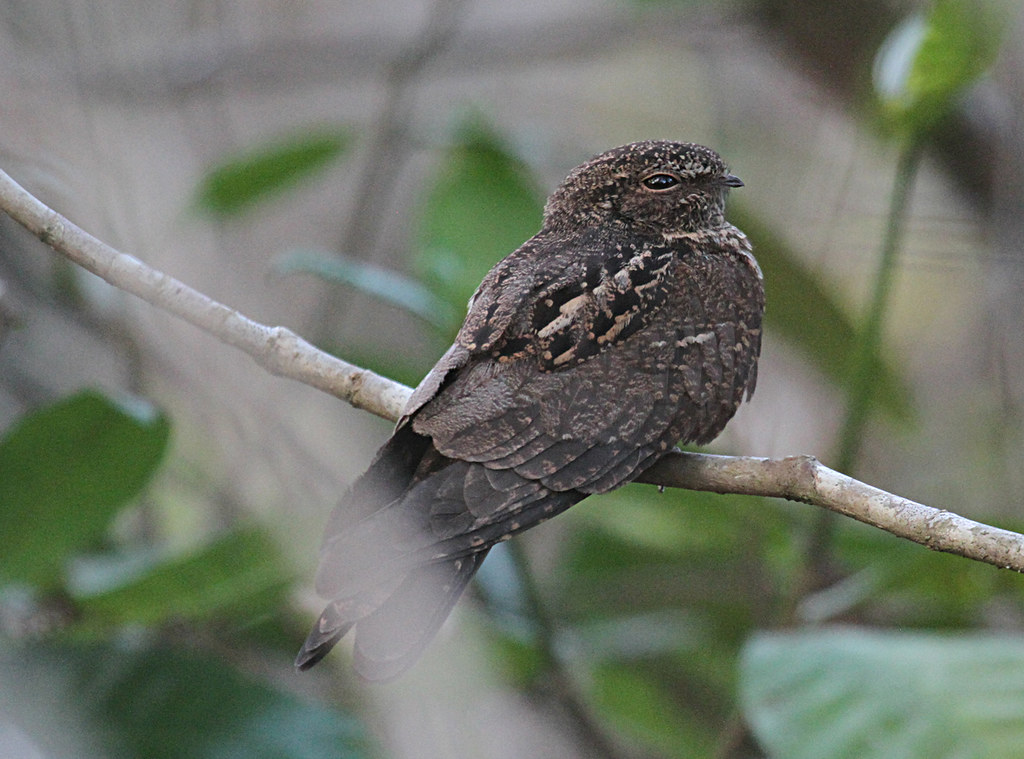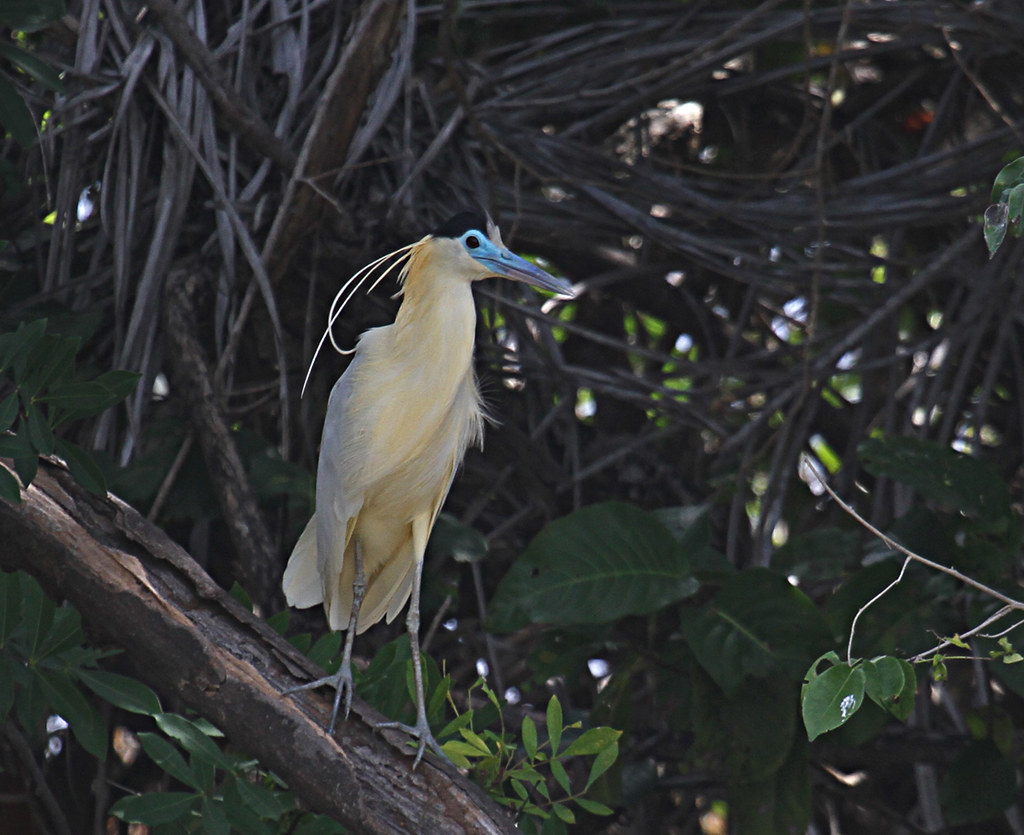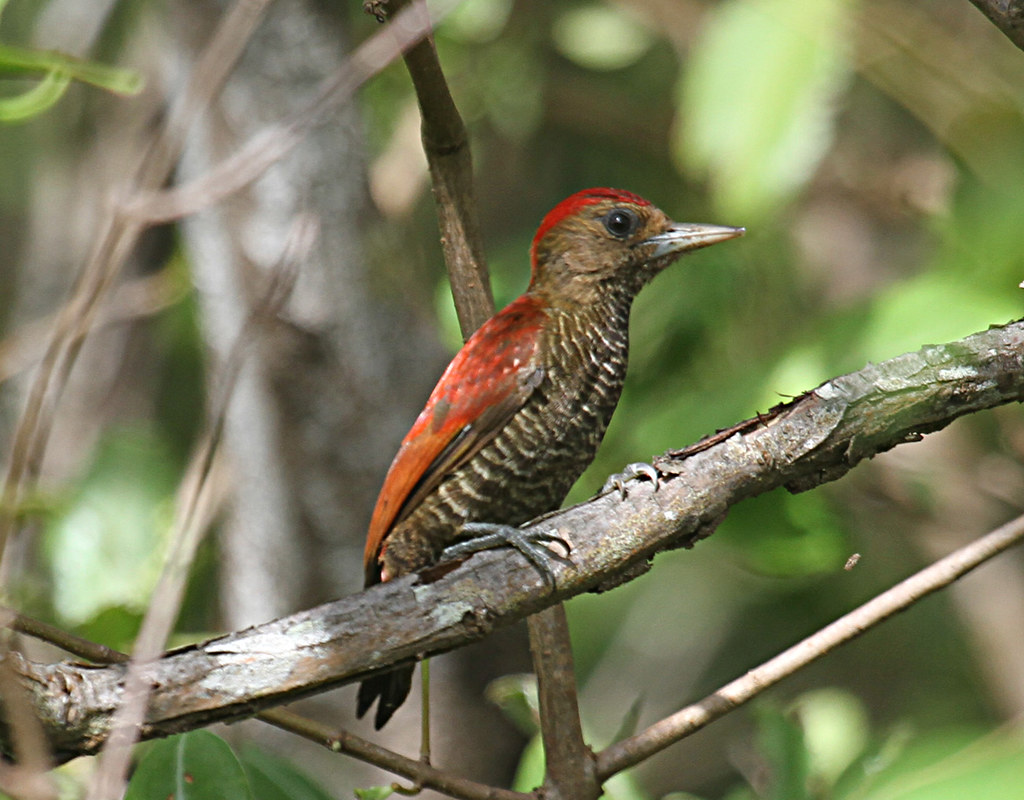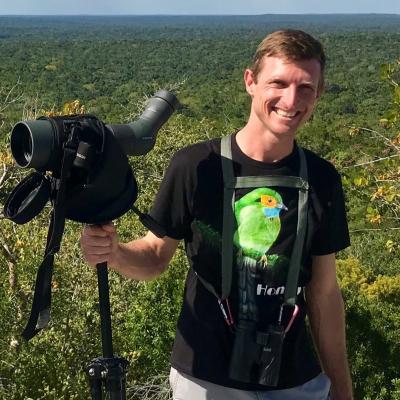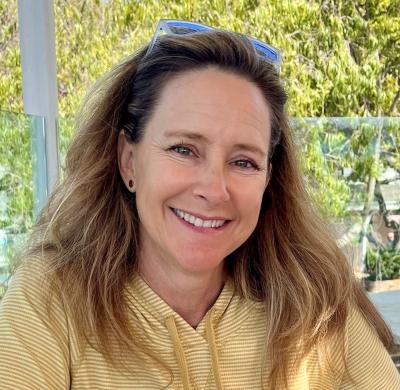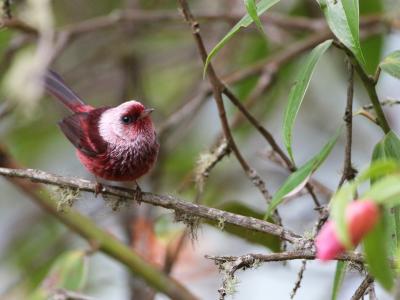Day 1: The tour begins at 6:30 p.m. with a meeting in the lobby of our hotel in Georgetown, Guyana. Night in Georgetown.
Day 2: We’ll depart before dawn, heading east along the coast to the Mahaica River. We’ll spend a couple hours birding from a small boat along the river, looking in particular for Guyana’s national bird, the Hoatzin. We’ll also enjoy a number of other riverside birds, perhaps including Green-tailed Jacamar, Long-winged Harrier, Silvered Antbird, Black-capped Donacobius, Little Cuckoo, and Yellow Oriole. We’ll also have our first chance to search for a few regional specialties, including White-bellied Piculet and Blood-colored Woodpecker. After breakfast at our boat captain’s house, we’ll continue birding the nearby rice fields and patches of mangroves, looking for various waterbirds and perhaps even the local Rufous Crab Hawk. After an almost full morning here we’ll backtrack toward Georgetown, with at least one stop to check the mangrove-lined coastal mudflats. Our chief target here among the throngs of waders and passing seabirds is the aptly named Scarlet Ibis. The intensity of this bird’s red plumage, especially set against a backdrop of Snowy Egrets and Little Blue Herons, should form an indelible memory of color. Additionally, we should encounter numbers of Snail Kites, Limpkins, and Wattled Jacanas, among others.
After lunch at our hotel and a siesta, we’ll spend the remaining few hours of daylight at the Georgetown Botanical Gardens. This urban park is home to quite an impressive variety of birds, including several species of parrot (Festive, Orange-winged, Yellow-crowned), Red-shouldered Macaw, Blood-colored Woodpecker, White-bellied Piculet, Gray Kingbird, Violaceous Euphonia, Wing-barred Seedeater, and much more. Night in Georgetown.
Day 3: After breakfast, we’ll transfer to the nearby airport at Ogle for our charter flight to the interior. We’ll fly past the Demerara and Potaro Rivers and over hundreds of miles of unbroken tropical rainforest to land at Kaieteur, the world’s largest single-drop waterfall (by volume) and also spectacularly tall at 741 feet. This amazing waterfall is one of the scenic highlights of the tour; we’ll appreciate its grandeur from our plane as well as from the ground on a short and easy hike. We’ll have a packed lunch at Kaieteur and explore the trails around the falls, looking for Guianan Cock-of-the-rock in the forest and perhaps even Orange-breasted Falcon or White-tipped Swift cruising around the spectacular cliffs.
We’ll then continue to make the journey toward Iwokrama River Lodge, flying to a small airstrip at Fairview and driving the short distance to our lodge. After some time to settle into our rooms at Iwokrama, we’ll enjoy some evening birding on nearby trails (perhaps including the bizarre Capuchinbird), before having dinner overlooking the pristine rainforest and river. Night at Iwokrama River Lodge.
Day 4: The Iwokrama Rainforest is a vast wilderness of one million acres, established in 1996 as the Iwokrama International Centre for Rainforest Conservation and Development and located in one of the last four untouched tropical forests of the world, the Guiana Shield of northeastern South America. This is a protected area with a difference: the full involvement of people. Iwokrama is exceptional among conservation organizations because it joins with local people in every aspect of its work, from research to business, ensuring local economic and social benefits from forest use and conservation. On our first morning we’ll bird along the trail to Turtle Mountain. This two-mile-long trail winds up to about 950 feet and, although steep in places, has handrails and steps to make the passage manageable. The open understory of the lower trail makes it easy to watch mixed-species flocks, and here we’ll seek out birds such as Fasciated, Cinereous, Dusky-throated, and Amazonian Antshrikes, Brown-bellied Stipplethroat, Black-chinned and Common Scale-backed Antbirds, Wedge-billed and Buff-throated Woodcreepers, and if we’re very lucky, maybe even Red-and-black Grosbeak or Yellow-billed Jacamar! We’ll spend some time at a small clearing along the trail, looking for Black Nunbirds and Guianan Trogons along the edge. Once the trail starts climbing, the character of the forest rapidly changes. Mixed-species flocks are regular in the canopy along the upper part of the trail, where the shorter trees allow for slightly easier viewing. Here we might encounter birds such as Red-legged, Green, and Purple Honeycreepers or Spotted, Paradise, Bay-headed, and Opal-rumped Tanagers.
In the afternoon we might take a boat down the Essequibo River, where we could see Anhingas, Ospreys, and Green Ibis along the riverbanks, Black-collared Swallows cavorting over the rocks and rapids, and parrots (possibly including Dusky and Red-fan) fly overhead. We might take another walk on a trail or along the road and search for any species we’ve missed so far. Night at Iwokrama River Lodge.
Day 5: We’ll have some time this morning to explore some other trails around Iwokrama before loading up and continuing over to Atta Lodge. Along the way, of course, we’ll keep our eyes open for roadside flocks, perched raptors, and parrots (and perhaps a few cotingas) or whatever else strikes our interest. Possibilities include Marail and Spix’s Guans, Great Black Hawk, Paradise Jacamar, and Pompadour Cotinga. We’ll make a stop in an area of white sand forest known as the Mori Scrub, where we hope to encounter the local Black Manakin as well as Rufous-crowned Elaenia, Red-shouldered Tanager, Olivaceous Schiffornis, and Bronzy Jacamar.
Arriving at Atta Lodge for lunch, we’ll then have some time to settle into our rooms and keep an eye out for birds around the lodge clearing (including a chance for the rare Crimson Fruitcrow). Our afternoon will likely be spent birding along some trails near the lodge. Night at Atta Rainforest Lodge.
Days 6-7: We have two full days to explore the forest around Atta Lodge. The trails are excellent, and we’ll likely spend some time birding right around the lodge clearing. Another major attraction here is the nearby Iwokrama Canopy Walkway. The 500-foot-long walkway has three platforms, the highest of which is about 100 feet above the ground. These could allow us to get great looks at a range of canopy species, many of which are difficult to see well from the forest floor. We’ll probably spend a couple hours birding from the walkway, where the flocks traveling past could include Paradise Jacamar, Guianan Puffbird, Yellow-throated and Waved Woodpeckers, Todd’s and Spot-tailed Antwrens, Black-tailed Tityra, and Dusky Purpletuft, or we can bird along the jungle trails, where antbird flocks can include White-plumed and Rufous-throated Antbirds, White-flanked and Long-winged Antwrens, and Cinereous and Dusky-throated Antshrikes. Roadside birding nearby could provide us with views of parrots such as Red-fan or Blue-cheeked, along with Rose-breasted Chat or Ringed Woodpecker. At least one evening will be spent on the roadside hoping for a glimpse of the rare White-winged Potoo. Nights at Atta Rainforest Lodge.
Day 8: After a brief morning’s outing around Atta, where we could encounter species such as Pied Puffbird, Red-throated Caracara, and Amazonian Grosbeak, we’ll start our transfer to Surama Ecolodge. On the way, we may stop at one or more trails for some additional birding time before heading to Surama: Gray-winged Trumpeter, Black Spider Monkey, Guianan Cock-of-the-rock, and Ferruginous-backed Antbird are all possible. If there is an active Harpy Eagle nest along our route, we will make an effort to get into the forest to see this incredible bird. We’ll then continue on to Surama Ecolodge for lunch.
On arrival at Surama we’ll receive a welcome from the lodge staff and settle into our accommodation. The pleasant community of Surama is set in five square miles of savanna and surrounded by the densely forested Pakaraima foothills. Surama’s inhabitants are mainly from the Macushi tribe and still observe many of the traditional practices of their forebears. The rooms have recently been upgraded, and our meals will feature excellent local produce. There is great birding leading to the village and in the surrounding savanna, and we may see Savanna Hawk, Great Potoo, Fork-tailed Palm-swift, and Red-bellied Macaw during the drive to the lodge. For our first afternoon here we’ll likely explore the forest edge and open savanna looking for species such as Black, Crested, and Yellow-headed Caracaras, Scaled Pigeon, Plain-crested and Lesser Elaenias, Cayenne Jay, Ruddy-breasted Seedeater, and Finsch’s Euphonia. As dusk falls, Common Pauraque, White-tailed Nightjar, and Lesser Nighthawks often appear around the lodge grounds. Night at Surama Ecolodge.
Day 9: For our full day at Surama we’ll likely concentrate on the forests around the Burro Burro River. There are several interesting species to be seen here, one of the undoubted specialties of the area being Rufous-winged Ground-Cuckoo. While this species is very tough to find, the nearby forests are certainly among the better places in the Neotropics to look for it –but of course there are no guarantees. Ant swarms are surprisingly regular here and often have attendant antbirds and woodcreepers, including the hard-to-pin-down Rufous-throated Antbird and possibly the even scarcer Red-billed Woodcreeper. More regular possibilities include Great Jacamar, Black-necked and Green Aracaris, Crimson-crested and Red-necked Woodpeckers, Rufous-bellied Antwren, and White-crowned and Golden-headed Manakins. Night at Surama Ecolodge.
Day 10: We’ll have one more full morning of birding at Surama, with an exact plan depending on what birds we haven’t seen yet. After some time to pack up and a nice lunch, we’ll start our transfer to Manari Ranch, which should take around three hours. The transition from the forest to the savanna will be stark: a reminder of how our birding will change, too, for the next several days. We’ll arrive in the heat of the day and have a siesta, followed by some easy birding around the lodge grounds before sunset.
Day 11: Today we’ll watch the sunrise over the savanna as we drive towards the village of Karasabai…with a very special goal in mind: our primary target today is the stunning Sun Parakeet, a bird so bright and colorful you almost need sunglasses to watch it. If all goes according to plan, we’ll have a picnic breakfast just after dawn while scanning the rolling hills for flocks of parakeets, and depending on our luck, we should have some extra time to search for various other species. Possibilities include Green-tailed Jacamar, White-bellied Piculet, Black-crested Antshrike, Southern White-fringed Antwren, Blue-backed Manakin, Pale-eyed Pygmy-Tyrant, and Burnished-buff Tanager.
This day will require a very early departure (probably around 4:00am) from Manari Ranch; the drive to Karasabai usually takes two to three hours depending on the road conditions. We’ll arrive back at Manari Ranch in the mid-afternoon and will have a couple hours of free time before dinner, in preparation for another very early start the following morning. There will be time for some optional independent birding around the grounds. Night at Manari Ranch.
Day 12: We have another very early start this morning (3:30 am), but don’t worry, we’ll be gently rocked back to sleep (if you so desire) in the back seat of a 4-wheel drive vehicle while riding along dirt roads…this time, heading to the village of Sand Creek to look for the endangered Red Siskin! This stunning bird is highly localized and we’re heading to one of the best places in the world to see it. It might take some patience and effort to find the siskins, but there are plenty of other birds in the surrounding patches of woodland to keep us occupied, including Plain-breasted Ground-Dove, Sooty-capped Hermit, Rusty-winged Antwren, White-bellied Antbird, Amazonian Scrub-Flycatcher, Pale-bellied Tyrant-Manakin, and Plumbeous Seedeater.
After checking in at the village of Sand Creek, where the community has recently taken a keen interest in conversation and ecotourism, we’ll continue our journey to Wichabai Ranch for lunch. Along the way, we’ll be sure to look for open savanna and wetland species like Bearded Tachuri, Pinnated Bittern, and Sharp-tailed Ibis. After a delicious lunch, we’ll work our way back to Manari Ranch in time for dinner. Night at Manari Ranch.
Day 13: Our main birding stop this morning will be at the Ireng River, which holds a few specialties that we won’t see elsewhere on the tour. With luck, these will include Hoary-throated Spinetail and Rio Branco Antbird. It will be a fairly leisurely day compared to the previous two, with a relaxed lunch at Manari Ranch followed by a transfer to the airport in Lethem for our flight back to Georgetown. After arriving back at the Ogle airport in Georgetown, we’ll transfer to Cara Lodge for our farewell dinner. Night in Georgetown.
Day 14: The tour concludes this morning with a transfer to the airport for international flights home.
Last updated Jan 17, 2025
































